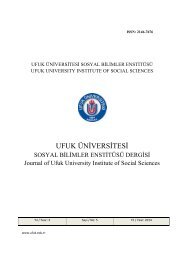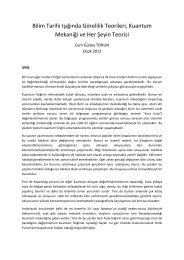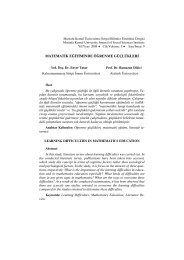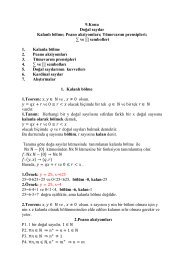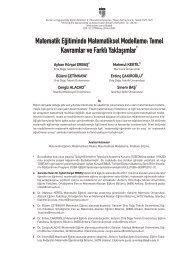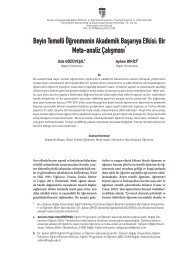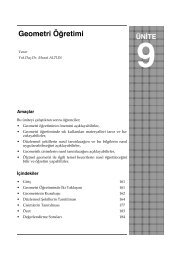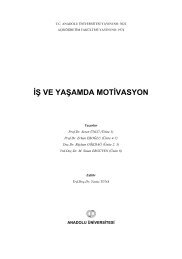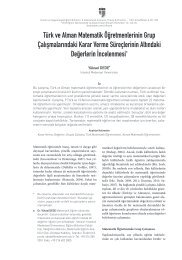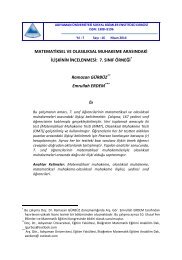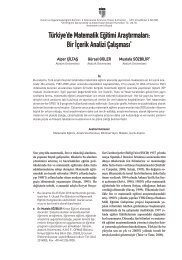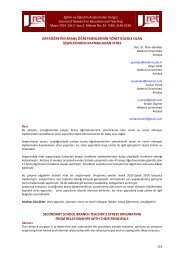NEWSLETTER
2015-12-98
2015-12-98
You also want an ePaper? Increase the reach of your titles
YUMPU automatically turns print PDFs into web optimized ePapers that Google loves.
Interview<br />
Who were your most important colleagues over your career?<br />
There is Friedrichs but also two other students of Courant:<br />
Fritz John, 4 a wonderfully talented mathematician<br />
who later became a faculty member (I had the fortune<br />
of writing one paper with him) and Hans Lewy 5 (I wrote<br />
several papers related to some of his work). Hans left<br />
Germany immediately after Hitler came to power. He<br />
came to the United States and had a career at Berkeley.<br />
Partial differential equations and inequalities<br />
Your name, often with various co-authors, is attached<br />
to many fundamental concepts and theorems in PDEs.<br />
If you just look at the citation list, your work has had<br />
a tremendous impact. Let’s start with Fritz John, with<br />
whom you authored a very influential paper about<br />
BMO functions (BMO standing for “Bounded Mean<br />
Oscillation”).<br />
That was his idea. He introduced BMO functions. It came<br />
from some work he had done in elasticity theory. He approached<br />
me saying: “I have a class of functions and I<br />
believe they should have such-and-such a property.” I<br />
worked on it and was able to prove that property. He<br />
then improved it so the final version is better than what I<br />
had done. It became a joint paper and I must say a lot of<br />
people have referred to it.<br />
Absolutely! It became famous – if we may say so – because<br />
of the many applications. For instance, Charles<br />
Fefferman got the Fields Medal in 1978 and one of his<br />
main contributions was to show that the BMO space is<br />
dual to the Hardy space H 1 .<br />
Charles Fefferman did many things but in particular, he<br />
proved the duality result that you refer to.<br />
Your paper with Fritz John contains the John–Nirenberg<br />
inequality. You love inequalities?<br />
I love inequalities. And what we proved in the paper was<br />
really an inequality.<br />
Would you explain why inequalities are so important in<br />
the theory of PDEs?<br />
When you look at a partial differential equation, you may<br />
ask whether a solution exists. Now, you can’t write down<br />
the solution so you need to know some bounds. It cannot<br />
be too big, it cannot be too negative, its derivatives cannot<br />
be too big and so on. You try to get estimates of the size of<br />
the function and of its derivatives. All these estimates are<br />
inequalities. You are not saying that something is equal<br />
to something but that something is less than some constant.<br />
Thus, inequalities play an essential role in proving<br />
the existence of solutions. In addition, you want to prove<br />
properties of solutions and, again, inequalities play a central<br />
role. Hence, inequalities are absolutely fundamental<br />
to studying partial differential equations; for that matter,<br />
so are they for ordinary differential equations.<br />
4<br />
1910–1994.<br />
5<br />
1904–1988.<br />
Let’s move on to your joint research with Shmuel Agmon<br />
and Avron Douglis. 6 There were two very important<br />
papers. Can you explain what they contained?<br />
What we did was to extend some classic work, by the Polish<br />
mathematician Schauder, to higher order equations. 7<br />
There is a fundamental paper of Schauder for secondorder,<br />
so-called elliptic equations. We thought it would<br />
be useful for people to be able to deal with higher order<br />
equations and systems of equations so we proved the<br />
analogues of those results. In the other paper, we proved<br />
the results for systems and also for different norms, that<br />
is, for different ways of measuring the size of the solutions.<br />
We published several different kinds of inequalities<br />
and they have been used by many people.<br />
You wrote a paper with Joseph Kohn introducing the<br />
important notion of pseudo-differential operators. You<br />
are one of the fathers of that concept. Can you explain<br />
why this concept is so important and how you came<br />
upon it?<br />
Joe Kohn had published a fundamental paper in complex<br />
analysis. It involved the regularity of solutions for<br />
a certain class of systems up to the boundary – a rather<br />
difficult paper! He suggested we should try to generalise<br />
this to more general systems of equations. We started to<br />
look at it and we had to consider so-called commutators<br />
of operators. You apply an operator and then you apply<br />
a second one. Then you take the difference of that result<br />
with the operator obtained by applying the second one<br />
and then the first. We needed properties of the commutator.<br />
We were using a certain space, called an L p -space,<br />
and a theory due to Calderón 8 and Zygmund 9 for certain<br />
singular integral operators. We needed to extend their result<br />
to commutators so we thought: “How do we extend<br />
these singular integral operators to make an algebra out<br />
of them?”<br />
That led to what we call pseudo-differential operators.<br />
The concept came from a very specific problem in<br />
systems of partial differential equations but it turned out<br />
to be a useful thing in itself. It grew out of Calderón and<br />
Zygmund’s theory. By the way, Calderón was a wonderful<br />
mathematician and he danced the tango, which I admired<br />
enormously.<br />
You had a very bright student, August Newlander, with<br />
whom you wrote a very important joint paper in 1957.<br />
Can you tell us about the results you proved there?<br />
It was a problem I first heard of from André Weil. 10 He<br />
said: “Here’s a problem in complex analysis. Why don’t<br />
you people in partial differential equations work on this<br />
kind of problem?” I thought: “Why not? Let’s try.” I took<br />
a student who was very bright and I said: “Let’s look at<br />
the very simplest case, in the lowest dimension.” The student,<br />
Newlander, had the initial idea, which worked fine<br />
6<br />
1918–1995.<br />
7<br />
1899–1943.<br />
8<br />
1920–1998.<br />
9<br />
1900–1992.<br />
10<br />
1906–1998.<br />
EMS Newsletter December 2015 35




